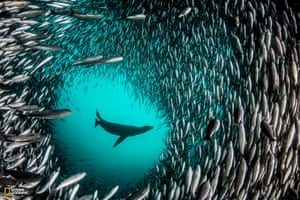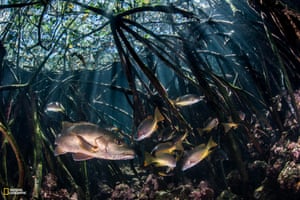http://e-info.org.tw/node/114100
全球鯊魚密度最高 加拉巴哥群島新設海洋保護區
文字大小
96 2 Share1
本報2016年3月25日綜合外電報導,姜唯編譯;蔡麗伶審校
加拉巴哥群島如今將擁有新的海洋保護區,面積約和比利時國土一樣大,保護全世界密度最高的鯊魚族群。
加拉巴哥群島的鯊魚。圖片來源:Niall Kennedy(CC BY-NC 2.0)。
厄瓜多新設立的保護區面積約3萬8000平方公里,涵蓋群島32%的水域。圍繞最北邊的達爾文島與狼島,將禁止所有漁業活動,以保護當地鯊魚與相關生態系。群島其他地方也設立許多較小的禁捕區。
截至目前,小型當地漁船仍被允許在保護區範圍內作業。厄瓜多政府表示,該棲地受到全球暖化、商業拖網和非法捕鯊取翅活動的壓力,需要加強保護。
全球鯊魚數量正急劇減少。據科學家估計,每年約有1億隻鯊魚遭殺害,佔鯊魚總數的6%至8%,遠超過族群繁衍速度。政府希望新保護區能作為鯊魚的繁殖基地,讓所有鯊魚長至成年,回到全球海洋。此外,政府也寄望新的和現有的保護區能促進國際海洋保育行動、取翅的反制行動和氣候變遷的因應。
加拉巴哥群島海域可見超過34種不同種的鯊魚,包括體型最大的鯨鯊、迴游性的雙髻鯊和加拉巴哥鯊。
聯合國世界遺產加拉巴哥群島,是達爾文演化論的發源地,也是科學家眼中無價的「活實驗室」。位於冷熱洋流匯集處,加拉巴哥群島是全世界生物多樣性最高的海域,有3,000種魚類、無脊椎動物、海洋哺乳動物、特有種海鳥以及全世界唯一的海鬣蜥。由於地處偏遠獨立,像加拉巴哥象龜等許多特有種仍保持著史前時代的模樣。
島上99%的陸地屬於自然保護區,禁止開發活動,旅遊活動亦有嚴格的限制。當地18年前就開始設立海洋保護區,禁止商業捕撈。
一份2015年的調查指出,加拉巴哥群島一隻鯊魚一生的觀光價值是540萬美元(約1億7582萬新台幣),而一隻死亡的鯊魚只值不到200美元(約6512新台幣)。
Ecuador creates Galápagos marine sanctuary to protect sharks
Belgium-sized area around northern islands of Darwin and Wolf will be off-limits for fishing in bid to conserve sharks and unique habitat
Ecuador has created a new marine sanctuary in the Galápagos Islands that will offer protection to the world’s greatest concentration of sharks.
Some 15,000 square miles (38,000 sq km) of the waters around Darwin and Wolf - the most northern islands - will be made off limits to all fishing to conserve the sharks that congregate there and the ecosystem on which they rely.
Several other smaller “no-take” areas have also been created throughout the volcanic archipelago, a biodiversity hotspot around 600 miles (1,000km) off the coast of Ecuador in the Pacific Ocean.
The announcement of the new reserve, which is the same size as Belgium, means that 32% of the waters around Galápagos will now be protected from fishing and other extractive industries. It will be incorporated into the existing 80,000-square mile marine reserve created in 1998.
Until now, small-scale local fishing cooperatives had been allowed to operate in the area, but the government says additional protection is now essential as the habitat has come under increased pressure from global warming and incursions by industrial trawlers and illegal shark fin hunters.
More than 34 different species of shark can be found off the shores of the Galápagos including the largest shark species, the filter-feeding whale shark, the migratory hammerhead shark and the Galápagos shark.
The world’s shark populations are in steep decline. Scientists estimate that about100 million sharks are killed every year, representing 6-8% of all sharks and far outstripping the ability of populations to recover.
The government hopes the new protection will support a breeding ground that can allow sharks to grow to full size and repopulate the world’s oceans. It hopes the shark sanctuary, together with the existing marine reserve, will strengthen international pressure for ocean conservation, action on shark finning and more ambitious action on climate change.
Environment minister, Daniel Ortega Pacheco, said: “These pristine waters around the Galápagos archipelago are precious not just for Ecuadorians but for the whole balance of our ocean systems. Shark populations in steep decline around the world come here to rest and breed and we want to guarantee complete sanctuary for them.”
The Galápagos Islands were the source of Charles Darwin’s theory of evolution and are seen as a priceless “living laboratory” for scientists.
The combination of cold and warm ocean currents make it one of the most biodiverse marine habitats in the world, supporting almost 3,000 species of fish, invertebrates and marine mammals, endemic seabirds and the world’s only marine iguana. Because of their remote and isolated nature, many species - such as the famous giant tortoises - are found only in the Galápagos and have not changed much since prehistoric times.
Almost 99% of the land area of the islands, which are recognised by Unesco as a world heritage site, are protected as a nature reserve with no habitation allowed and strictly-regulated tourism. The existing marine reserve - one of the world’s largest - was created 18 years ago to protect the unique habitat from industrial fishing.
At the launch of the newest reserve, Ecuador’s president, Rafael Correa, will say: “The establishment of this marine sanctuary represents a major breakthrough, not least because it hosts the largest biomass of sharks in the world, which is an indicator of the pristine condition of the site as well as the importance of conservation.”
The scheme has been supported by the National Geographic Foundation, which has offered compensation to the local fishing cooperatives. The government says evidence from other no-take zones around the world shows there is net benefit for local fishermen through an increase in fish numbers outside the protected zone.
A 2015 economic study calculated that the tourism value of a shark over its lifetime in the Galápagos is US$5.4m (£3.75,) while a dead shark brings in less than US$200.




沒有留言:
張貼留言